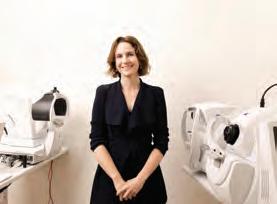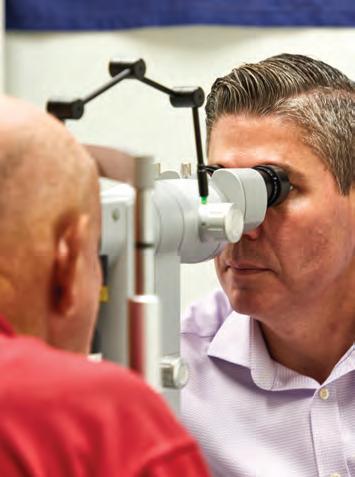
8 minute read
GLAUCOMA FEATURE
By TRACEY JOHNSTONE
Glaucoma acts by stealth developing slowly and often without symptoms. If it’s left undetected, it can cause vision loss and even blindness.
Advertisement
The bad news is it’s not reversible.
The good news is that if glaucoma is detected early and tgeated, your sight can be saved.
You may be at a heightened risk of glaucoma if you have a family history of the condition, high eye pressure, are of African or Asian descent, have diabetes, are short or long sighted, have been on a prolonged course of steroid medication, experience migraines, have had an eye operation or eye injury, have high or low blood pressure or experience obstructive sleep apnoea.
Glaucoma Australia says there is a 10 times greater chance of developing glaucoma if a direct relative has been diagnosed with this condition. If you are diagnosed with glaucoma, you should tell your closest family members.
The loss of sight due to glaucoma is usually gradual and a considerable amount of peripheral or side vision may be lost before there is an awareness of any problem. Glaucoma Australia says about 50 per cent of people don’t even know they have glaucoma.
As a good health management rule it’s wise to get your eyes fully tested by an optometrist every two years.
If diagnosed with glaucoma the most common form of treatment is eye drops. Laser and surgery are also used.
It’s vital you follow your treatment plan and attend follow-up appointments.
Glaucoma is a life-long and often progressive condition, but appropriate treatment can prevent vision loss.
If your optometrist has flagged you may have a glaucoma problem in the future then put a reminder in your diary to keep on top of your checks as early detection may just save your vision. Glaucoma is a leading cause of vision loss among the adult population globally and in Australia. It is estimated that there are 300,000 Australians living with glaucoma, but over 50% are unaware they have it. Left untreated, it can lead to vision loss and even total blindness.
While commonly called glaucoma, it is actually a group of eye diseases where sight is lost due to damage to the eye’s optic nerve.
The optic nerve is like an insulated cable transmitting signals along your optic nerve cells - which act like wires - from the light receptors in the eye to your brain.
We are born with about 1 million of these cells, but they slowly reduce in number with age. People with Glaucoma lose these cells at a higher rate than most and so they start to lose vision.
The loss of sight is usually gradual and starts in the periphery, or the side of your vision. As this occurs in the periphery, much vision may be lost before there is an awareness of any problem.
While there are different types of glaucoma, Primary Open-Angle Glaucoma is the most common, with 90% of glaucoma cases in Australia. It is nicknamed the ‘sneak thief of sight’ because there are no obvious symptoms in the early stages of Primary Open-Angle Glaucoma. Another type of glaucoma is called Acute Angle-Closure Glaucoma which can cause severe eye pain associated with nausea and vomiting, headache, watery eyes, sudden onset of blurred vision and seeing halos around lights. This is a medical emergency; immediate treatment is required and anyone with these symptoms should present immediately to a hospital emergency department.
Unfortunately, there is no cure yet for glaucoma and any vision loss that occurs is irreversible. However, we can slow down the rate of progression with treatments provided by an ophthalmologist.
When you have your regular visits to your optometrist, they will check to see if there are signs of glaucoma, or if you are at risk of developing it. Risk factors for glaucoma include age, family history, short- or longsightedness, obstructive sleep apnoea and diabetes. Optometrists will refer you to us if they are concerned you have signs or risk factors for glaucoma. For more information and resources see Glaucoma Australia (www.glaucoma.org.au/what-isglaucoma) or visit our website at Insight Eye Surgery (www. insighteyesurgery.com.au/). Insight Eye Surgery. Eye care about you in Noosa, phone 07 5345 5011
Enjoy your best life with clear vision
Insight Eye Surgery provides the highest quality eye care to enhance, preserve and restore vision. We do this by combining state-of-the art technology with the latest techniques. We provide a personalised service with clear communication in a friendly, caring environment.
Dr Madeleine Adams (MB ChB BSc(Hons) PhD FRANZCO) is an experienced refractive cataract surgeon and comprehensive ophthalmologist.
Insight Eye Surgery takes care of: • Cataracts • Macular degeneration • Pterygium • Refractive lens exchange • Glaucoma • Dry eye disease and ocular surface optimisation

Ask your GP or optometrist for a referral today. Insight Eye Surgery is a Known Gap Provider, conveniently located at 1/31 Thomas Street, Noosaville QLD 4566 www.insighteyesurgery.com.au | Telephone: 07 5345 5011
Glaucoma is the name given to a group of eye diseases where vision is lost due to damage to the optic nerve. It is often, but not always, associated with a gradual rise in intra-ocular pressure. Most commonly, the patient is unaware they have a problem until it is too late. Unfortunately there is no cure for glaucoma. Early diagnosis and correct treatment are essential.
Glaucoma can cause peripheral visual field loss resulting in reduced awareness of objects and people in our side or peripheral vision. Central (straight ahead) vision is often unaffected in the early stages of glaucoma, so our ability to see clearly is unchanged. Initial changes in the visual field are subtle but can be detrimental to our safety on the road. Often, when small areas of vision disappear, the brain fills in the image to create an inaccurate but believable scene in the part of the visual field that is diminished. This is called the “filling-in-effect”. The filling-in-effect influences our visual perception when driving and impairs our ability to see hazards on the road such as pedestrians, bike riders, other vehicles, road debris or potholes.
Visual field loss from glaucoma can also enlarge our blindspot when driving and impede our ability to safely merge into traffic or change lanes.
Reduced peripheral vision can also hinder our ability to rapidly adapt to dynamic variations in lighting, such as when we are driving through a series of shadows cast on the road. Our ability to drive at night and adjust to oncoming headlights and streetlights can also be hindered.
Contrast is our ability to see how faded an image is before it becomes indistinguishable. Changes to vision as a result of glaucoma can cause subtle and unconscious changes in our contrast vision. Good contrast vision is important to be able to see pedestrians, other vehicles and hazards in poor lighting conditions and on overcast and rainy days.
Because glaucoma has very few symptoms, patients are often unaware they have a problem. A regular eye examination with an optometrist, timely referral if necessary, and adequate treatment are all essential in the management of glaucoma. Visit www.sconoosa.com.au Glaucoma, the death of the nerve fibres connecting the eye to the brain, is the second leading cause of blindness worldwide. Based on epidemiological studies, 2% of Australians over 50 likely have glaucoma, and 50% of these people remain undiagnosed.
We can prevent vision loss from glaucoma through early diagnosis and management. If you have a family history of glaucoma, your risk may be as high as 25%. Called the thief of sight, the only way to detect glaucoma is through testing conducted by your optometrist or ophthalmologist.
All persons over 50 should be checked for glaucoma at least every two years unless you have a family history of glaucoma, then every six months to 1 year.
Glaucoma damage is irreversible, and treatment aims to prevent further damage and vision loss. The more advanced the disease is at diagnosis, the harder it is to treat and the more likely you are to lose significant vision.
To find out if you have glaucoma, book an appointment with your optometrist or ophthalmologist to get a check.
Drops have been the mainstay of glaucoma treatment for many years. Many people can now become drop-free by using new technologies and treatment options available for glaucoma, including Selective Laser Trabeculoplasty (SLT) and Minimally Invasive Glaucoma Surgery (MIGS) reduce the drop burden.
Not all treatment options are suitable for every patient. If you have glaucoma and would like to explore your options for treatment, speak to an eye specialist with experience in these new treatment modalities. Visit bestpracticeeyecare.com.au


Care for a puppy in 2022!
Calling all Sunshine Coast puppy lovers

Could you care for a puppy this year? Want to make lifelong friends with like-minded puppy carers?
Your role as a carer is to: • Nurture and socialise the puppy • Provide a safe space where the puppy can sleep indoors • Not leave the puppy alone for more than 3.5 hours
Online session via Zoom:
Date: Monday March 21, 2022 Time: 11am - 12pm AEST All welcome

As a puppy carer, you will be supported by expert puppy development trainers online and in-person. All expenses covered.




















